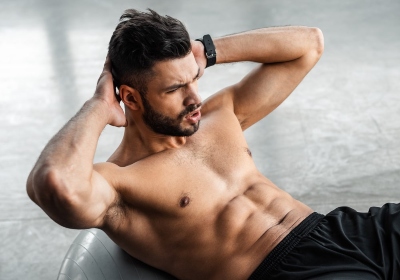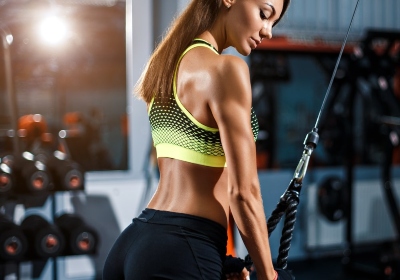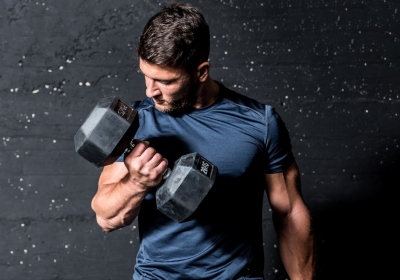VIDEO
Dumbbell Single Leg Romanian Deadlift
- Abs
- Wrists
- Biceps
- Triceps
- Upper Back
- Lower Back
- Shoulders
- Quads
- Hamstrings
- Thighs
- Chest
Level:Advanced
Trainer:Nick Taylor
Equipment:Dumbbell
Dumbbell Single Leg Romanian Deadlift
- Abs
- Wrists
- Biceps
- Triceps
- Upper Back
- Lower Back
- Shoulders
- Quads
- Hamstrings
- Thighs
- Chest
Level:Advanced
Trainer:Nick Taylor
Equipment:Dumbbell
This exercise is going to test your posture, stability. This is a great exercise for hamstrings and Lower Back. Stay straight with your feet together and the dumbbell in one hand. Leave the left foot down on the floor bending at knee slightly. And start lifting the right foot behind at the same time tilting your body forward. Make the movement slowly and smooth. Make sure that your back is straight the whole time.
save to ...
RECOMMENDED FOR YOU
ARTICLES
This time we suggest paying special attention to the chest muscles. It is this zone that many athletes want to pump, but it is not so easy to do and one classic chest press is not enough.
Chest muscles are one of the most complex and largest muscle groups.
Therefore, competent training must be a combination of basic and isolation exercises. Only in this way, it will be possible to load the muscles at different angles. Exercises with barbells are suitable for increasing muscle mass, and with dumbbells, on blocks and training machines - for improving the form and detailed elaboration. These exercises also activate the stabilizing muscles.
Imagine that the chest muscle is a rubber band that connects the shoulder, collarbone, and sternum. If you lift your arm to the side and then pull the elastic band, it will move your shoulder forward. You do this movement all the time in your normal life like when you close a door, push something away with force, or elbow your jaw.
Most pectoral muscle exercises repeat this movement. The only difference is that they also use a barbell, dumbbells, or crossover slings to create extra resistance.
The chest muscle has two heads: an upper head (clavicle) and a lower head. Their functions are slightly different, and this is important. In order to have a symmetrical chest, you need to pump both heads.
The fibers of the clavicular head are directed upward, so you need to move the shoulder forward from the bottom to the top for additional exercise.
Many people believe that the more they pump their chest, the faster their muscle mass will increase. In fact, this has a negative effect on muscle growth. The muscle gets bigger during rest when the tissues are recovering from an active workout. There are a few tips on how to properly pump your pecs and not overtrain:
Exercise no more than 2 times in 7 days. In between do physical exercises on other parts of the body;
Do not exercise for more than 45 minutes, as this may cause muscle size and strong growth to regress.
Exercises that help you to pump the chest muscles include:
push-ups.
bench presses.
triceps push-ups.
To pump your muscles evenly, alternate your exercises. The bench press is great, but you don't have to do it in every workout, because there are other good options.
Choose the weight so that the last reps in an attempt are difficult. If you find it easy and your muscles don't tire, they won't grow.
Avoid flying in the clouds during the workout: concentrate on the muscle work. It really helps you to pump it better.
Perform 3-5 sets of 8-12 reps. Do not use weights that are too heavy. Especially at the beginning if you do not have a good command of technique.
Read more
Hamstring muscle training is often neglected, but for most athletes, however, it is very important because strong hamstrings help avoid many injuries.
They are a group of powerful muscles that extend from the pelvis to the knee at the back of the upper leg. Their two main roles are to extend the leg (pull it back) and bend the knee, movements we use both in mountain walking or running and in everyday life. We engage and overuse them more than we realize, which creates tension and can lead to acute or chronic injuries due to overuse. For example, when you run or hike up a mountain, it may seem like you are primarily using your quadriceps, but you are also straining your hams, especially if you are overzealous or taking a big step to navigating over rocks or roots.
These muscles consist of three parts: the semi-tendon muscle, the biceps femoris muscle, and the semitendinosus muscle. Together they form a large group of muscles that work at the base of the thigh. Their main function is to bend the leg at the knee joint.
Before performing any strength exercises, it is important to warm up and stretch the hamstring muscles well, because the muscles are often in a contracted condition.
Training
It is better, to begin with, a 5-10 minutes light workout. This can be cycling, running, etc. Such workouts are good for warming up before stretching, after which you can proceed to the main workout. Training cool muscles is not a good idea.
Wise advice for beginner athletes who want to train with extra weight - use a lighter load and more reps at first to gradually develop muscle strength.
There are many exercises that do not directly target your hamstrings, but where they help your hamstrings, such as pull-ups, lunges, and squats. However, to develop them well, it is also important to do some isolation exercises where you focus directly on your hams. To help you on your way, we decided to list the most important exercises below.
Hamstrings Compression helps relieve pain and tightness.
Stretching relieves stress and helps strengthen the ligaments in the back of the knee as well as the hamstrings.
Quadriceps stretching with support. This exercise will strengthen your hams instead of your quadriceps. It also improves knee mobility.
Leg lift with resting on arms. Lifting one leg is aimed at pumping the glutes, as well as strengthening the hamstrings.
Wall Squats. Such squats will strengthen your knees and also reduce pain if any. The exercise works all the muscles that are connected to the knees.
Lunges also engage your hamstrings, glutes, inner thigh muscles, and calves. The strength of these muscles determines the strength of your knees. The stronger they are, the more tension they will absorb, thus preventing injury and pain.
Exercises with a roller are a perfect way to massage and relax your muscles.
Read more
Since ancient times, developed muscles have been one of the hallmarks of a harmoniously developed, athletic body. There is no such thing as 'abs' in anatomy. This is a conditional abdominal muscle. There are four of them:
rectus;
internal oblique;
external oblique and transversus.
The rectus abdominis muscle is the largest in area. It’s a popular fallacy that there is a 'lower' and 'upper' press, but the rectus muscle does not have such a division. The notorious 'six-pack' stands out because of the tendon bridges on the rectus abdominis muscle. The muscle bundles of the external abdominal muscle begin from the lower eight ribs and extend radially downward. The transverse muscle is located deeper than the other abdominal muscles. In this case, the tendon extension in the upper two-thirds passes behind the rectus muscle, and in the lower third - in front. Partly because of this, the lower abs are less workable than the upper ones. The abdominal muscles are referred to as the core muscles, the muscle complex responsible for stabilizing the spine, pelvis, and hips. Each of the abdominal muscles is responsible for its own functions. One of the most common fallacies in abdominal training is that the more reps we do in a set, the stronger and bigger the abs will be. In fact, the muscles of the abs are no different in terms of training from the biceps. To increase the biceps, you will do one hundred reps per set. However, you will reduce the number of sets and reps, but increase the load. By increasing the number of repetitions in the set, you will develop strength endurance, but the muscle will not get thicker from this. It is much more effective to increase the load, do sets with weights and reduce the number of repetitions in the set. Three factors affect the appearance of your abs: posture, body fat percentage, and muscle development.
Posture.If a person pumps muscles but slouches, and he has excess fat, then the abs will not be visible. If a person does not pump the abs, but he has a good posture and a small percentage of body fat, then his belly will look flatter. That is why it makes no sense to start with the question of how to properly pump the abs. You need to start by working on your posture. The good news is that your core muscles are also responsible for correct posture. And they are usually used in workouts with an emphasis on the abs.
Fat percentage.Measuring body composition on an analyzer scale will show the percentage of body fat, which explains why the abs are invisible. If the fat is more than 15-20%, then it’s hard to see your six-pack. At 15% or less, the abs begin to be seen. 8% is abs athletes have. But do not try to completely get rid of fat for beautiful abs. Fat is necessary for the proper functioning of the endocrine system and other processes in the body. To achieve tangible results, it is important to monitor the factors that affect the percentage of body fat like food, sleep, stress levels, and the amount of daily physical activity.
Muscle development.You mustn’t focus only on abs exercises, you need to develop the body complexly and do a variety of activities. Strength training will strengthen your muscles, burn calories and build endurance with interval training. Recovery activities help with posture, flexibility, and muscle balance. The optimal training program can be selected after fitness testing, which takes into account how a person moves, what restrictions he has.
Read more
The muscle on the back of your shoulder is called the triceps. Triceps originate from the scapula and humerus and attach to the ulna using the triceps tendon. The triceps muscle does the function of extension in the elbow and acts as an auxiliary in the implementation of other movements in the shoulder. During triceps contraction, the vector of movement is transmitted using the tendon.
The mass fraction of the triceps is approximately 2/3 of the muscles of the shoulder, so its size plays a critical role in the formation of beautiful arms. By focusing on the biceps, and forgetting about the triceps muscle, athletes contribute to getting inharmoniously developed arms.
You shouldn't train your triceps more often than 1-2 times a week. Do not forget that many exercises for the pectoral muscles load the triceps, so make up the training program so that the triceps and pectoral muscles are trained on different and distant days, thus some periodization of the load is achieved.
But in some cases, the triceps can be trained on the same day as the pectorals, since all basic chest exercises involve the triceps and vice versa. This means that if you swing your chest, then the triceps already swing by themselves. To increase efficiency, do triceps workouts of different intensities: light-medium-hard, and so on. Rest for at least 1 week after a hard workout.
In classic splits, the triceps are usually the most overloaded muscle, due to the very specifics of training in split programs. To increase the volume of the triceps muscle, do 8-15 repetitions. The total number of triceps sets (the sum of the sets of all triceps exercises) is 3-6.
The basic exercises for pumping triceps are reverse push-ups on the bench and narrow grip barbell press. In addition, an important exercise is a pull of the upper block with a rope - one of the few that uses the lateral head in the work. Since the mechanics of movements are in many ways similar, it is recommended not to combine the presented exercises, but to alternate.
Training.
Reverse push-ups from the bench. Starting position - heels touch the floor, hands on the bench behind your back. Slowly lower your torso down, linger at the bottom point, then with an explosive force push your body weight up over the bench. The elbows are directed backward. To complicate things, use an extra load by putting the weight on your hips.
Bench press with a narrow grip. It’s the exercise to work out the medial head of the triceps. Lie on a bench (keeping your feet firmly on the floor), grab a barbell or dumbbell with a narrow grip, then lift the weight up. During execution, the elbows should be pressed as close to the body as possible.
Bent over triceps extension. It’s for pumping the long and lateral heads of the triceps. When pulling the arm back, make sure that the elbow does not change position (that is, do not swing the arm back and forth or left and right). Also, watch out for the arch of the back - to do this, keep the abs slightly tense.
Top pulldown with rope. A key exercise for pumping the lateral head of the triceps. The movement should be in the lower plane - that is, do not raise your arms higher than chest level. When doing it, make sure that the elbows do not change position, and the body does not swing.
Remember that when building the triceps, you need to correctly feel the amplitude of the exercises - achieving maximum involvement of the muscles without dangerous impact on the shoulder joint. For this, it is better to use an average working weight.
Furthermore, watch your shoulders and head - in particular, don't round your shoulders or lean forward. When doing triceps exercises, the chest should be open, the press should be tense. Otherwise, the load is transferred to the shoulder joints.
Read more
Biceps is the most famous muscle in the human muscular system, it is approximately one-third of the mass of the shoulder. It is a part of a group of three in the upper arm that works together with each other to lift the arm toward the shoulder. As one of the most visible and impressive parts of the body, “two-headed muscles” are often the gym’s focus.
It is responsible for two main movements of the arm. The first is raising your hand. Those who carry something using their arm are likely to engage them in the process, as some upward force must be applied during the process of carrying and lifting. The second movement, for which they are responsible, is called supination, which rotates the arm from the natural position of the palm down to the palm up.
Biceps are built as a result of injury, which is often achieved through lifting weights such as curls or other types of exercises. As the curls or other exercises are done, the muscles in the arm get minor injuries. These injuries must be repaired naturally. The recovery process, as a natural byproduct, usually leads to growth and strength gains, although this process can take several weeks or months before noticeable results are seen.
Very few exercises work for it without affecting the other parts of the shoulder. Therefore, there is no reason to worry that others in the upper arm might be neglected by focusing on them. Some may focus only on the arm and almost completely forget about the legs or the core.
As one of the most commonly used muscles in the body, the biceps can certainly be damaged. Biceps injuries are not as common as some other types of injuries, there is always a risk, especially among weightlifters. The most common type of injury is damage to the tendon. In this type of injury, It is pulled away from the tendon that attaches it to the arm in a bone also known as the radius. Such injuries occur when they are used suddenly or to a level that they cannot handle.
Training.
Dumbbell Bicep Curls. Stand straight with the dumbbell in each hand and with your feet shoulder-width apart. Once the dumbbells are at your shoulder level, start slowly lower your arms to the starting position. Repeat for the desired amount of repetitions.
Incline Pushup. Place your hands slightly wider than shoulder-width apart on a bench, chair, or couch. And assume a high plank position with your feet together and your body straight from head to heels. Keeping your feet flat and core engaged lower your chest to the bench or chair. Pause. And then push yourself back up to the starting position.
Diamond Knee Pushup. With your knees on the ground place your hands on the ground with your fingers and thumbs touching together creating the diamond shape. This action will engage more your tricep muscle. Then complete a push-up and get back to the starting position. Repeat for the desired number of repetitions.
Pike Pushup. Assume a shorter push-up position, get on your toes and put your butt up, shifting your weights to the front. Bending your arms slowly lower your head, be sure not to bump your head on the ground.
Read more
SAVE TO ...





